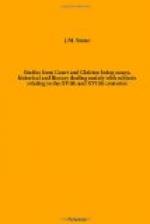All these demands on Cotton’s library and Cotton’s liberality, together with many more, may be seen in the collection of letters contained in the volume, the press-mark of which is Julius C 3.
The fame of the Cottonian library was great among the learned at the beginning of the seventeenth century; in 1612 it was spoken of with enthusiasm. The following letter from Edmund Bolton, poet and antiquary, is, despite its somewhat florid and inflated style, a proof of the high estimation in which the collection was held.
“Sir,—The world sees that worthy monument of witt and learning* come forth, but with honourable acknowledgements of special’ helps from you. But we that are somewhat privie to the truth of things, do also knowe that without your assistance, it is in vain to pretende to weightie works in the antiquities of this kingdom. For your studie, if we respect the glories of saints there carefully preserved in authentic registers, it is a Pantheon and all Hallowes. If the memorials of the honourable deceased, it is a mausolae. If the tables and written instruments of Empire, it is a Capitol. If the whole furniture of Cyclopxdia, it is a mart. If matters marine, it is an arsenal—if martial, a camp and magazine. Briefly it is the Arck, where all noble things which the deluges of impious vastitic and sacriligious furie have not devoured, are kept to bee the seminaries of better plantations.”
* Probably a reference to Bacon’s History of Great Britain under the Conquests of the Romans, Saxons, Danes, and Normans, published in 1611.
He goes on to compare Cotton’s library with that of Paulus Jovius, the pride and glory of Italy, which, he declares, “will seem perhaps little better than a beauteous charnel-house, filled with skeletons, and the rotten timbers of clay-built tenements dissolved into dust, by the side of this exquisitely instructed studie.”
Exaggerated as this praise may seem, the fact remains that the Cottonian collection was unique, and that scholars owed more to it than to any other sources of information. There is no account of any visit of Cotton’s to the Continent, although in one of his early pamphlets mention is made of his having visited Italy; but people were busy in different parts of Europe seeking for what was valuable in the shape of parchments and old coins, to add to his treasures.
England was, however, at that time the best hunting-ground for manuscripts, so short a time having elapsed since our great monastic libraries had been scattered to the winds. Chronicles, chartularies, State Papers, treaties, family pedigrees, documents of every kind were floating about the country, often in the possession of strange owners, almost always to be had for gold. To acquire these was Cotton’s chief delight from the age of eighteen; and as a natural consequence, this taste surrounded him with learned friends. At his house at Westminster the literati of the day were wont to meet. Josceline, Camden, Noel, Speed, Sir John Davis, and others formed, together with himself, the then Society of Antiquaries, which Matthew Parker had founded.




